This page contains the AQA GCSE Chemistry Periodic Table Questions and their kerboodle answers for revision and understanding Periodic Table.This page also contains the link to the notes and video for the revision of this topic.
Banner 1
C 2.1 Development of the periodic table AQA GCSE Chemistry C2 The Periodic Table Kerboodle Answers Page No. 23
1.Newland’s fellow scientists refused to accept the Newland law of octaves because he could classify elements up to calcium only. After calcium, every eighth element did not possess properties similar to that of the first. The elements that were discovered later could not be fitted into the octave pattern.
- a.Iodine and Tellurium are the other two elements other than argon and potassium that do not appear in the order of their relative atomic masses. Iodine has a lower relative atomic mass than tellurium, but iodine was put after Tellurium to match with the chemical properties of other halogens.
B Argon has a greater atomic mass than potassium. According to Mendeleev’s periodic pattern, potassium should come first followed by argon. This resulted in the placement of argon in the group of the most reactive metals like lithium, sodium, and potassium would be placed in the group of noble gases. Similarly,iodine has a lower relative atomic mass than tellurium, but iodine was put after Tellurium to match with the chemical properties of other halogens. This was the problem for Mendeleev as the periodic properties did not match amongst the elements. He, however, changed the orders and placed Argon first and Tellurium first. This problem was eventually solved by the modern periodic table which placed the elements according to their increasing proton number instead of atomic weights which placed Argon, Tellurium, Iodine, and Potassium in the correct groups.
3.Mendleev periodic table was a useful tool for the understanding of the chemical elements as he arranged the table in a pattern so that the element properties could be seen but also left gaps for elements that had not yet been discovered. A few years later, these unknown elements were discovered with properties that closely matched his predictions.
Banner 2
C 2.2 Electronic structure and the periodic table AQA GCSE Chemistry C2 The Periodic Table Kerboodle Answers: Page No. 25
1.a. Periodic means that the elements in the periodic table shows patterns in electronic configuration, physical and chemical properties and repeat itself with increasing atomic number.
The elements in the same group show similar chemical properties.
- (i) Vertical columns in the periodic table are known as group. Elements in the same group have similar chemical properties.There are 18 numbered groups in the periodic table.
(ii) Horizontal rows in a periodic table are known as periods. Elements in the same period have the same number of electron shells and they show trends in properties.
- a.There are more number of metal than a non metals in the periodic table. The metal are found to the left of the periodic table. About 91 of the 118elements in the periodic table are metals , and there are around 17 non-metals. So the percentage of metal is 77% and the percentage of non-metals is 14%.
b.When the metal react they lose electrons so the number of shells and number of electrons decreases when the metal react.
- A. Beryllium has 1 electron in their highest energy level as it is in group 1.
b.Boron has 3 electrons in their highest energy level as it is in group 3.
- Potassium has 1 electron in their highest energy level as it is in group 1.
D Helium has 2 electrons in their highest energy level.
e.Argon has 8 electrons in their highest energy level has it belongs to group 8.
f.Radium has 2 electrons in their highest energy level has it belongs to group 2.
g.Radon has 8 electrons in their highest energy level has it belongs to group 8.
h.Iodine has 7 electrons in their highest energy level has it belongs to group 7.
- Elements in the same group have similar chemical properties has they have same number of electrons in their outermost shell. The chemical properties of the element is determined by its electronic configuration and since they have similar electronic configuration they have similar chemical properties. .
5..Noble gases are unreactive as they have complete full outer shell. Since they have full outer shell they are stable and unreactive.
Banner 3
C 2.3 Group 1 – the alkali metals AQA GCSE Chemistry C2 The Periodic Table Kerboodle Answers Page No. 27
1..Alkali metals need to be stored under oil as they are highly reactive. They are stored in the oil to prevent them reacting with the oxygen and water vapor in the air.
- The melting points of the alkali metals decreases as their atomic number increases down the group. Down the group the strength of the metallic bond decreases due to decreases in nuclear charge resulting in decrease of both melting and boiling point down the group.
- The alkali metals form ion with a +1 charge as they have only one electron in their outermost shell and to attain a stable noble gas electron configuration they need to lose one electron.
- a.2Cs(s) + I2(g) → CsI(s)
Caesium metal reacts with Iodine to form an ionic compound Caesium iodide.
b.2Cs (s) + Br2 (g) →2CsBr (s)(
Caesium reacts with bromine to form Cesium iodide. .
- Answer.
The reactivity of group 1 elements increases down the group. Caesium is at the bottom of group 1 in the periodic table, hence it is highly reactive. When Caesium is dropped in water it will show violent explosion due to a rapid product of heat and hydrogen will be produced. The color of the universal indicator will turn violet or indigo due to the formation of strong alkali, caesium hydroxide. The reaction will be: –
| Word Equation: | Caesium + Water → Caesium hydroxide + Hydrogen |
| Formula Equation: | 2Cs (s) + 2H2O (l) → 2CsOH (aq) + H2(g) |
Banner 3
C 2.4 Group 7 – The halogens AQA GCSE Chemistry C2 Periodic Table Kerboodle Answers Page No. 29
1a. The melting points of group 7 elements increases down the group as the size of the atom increases which results in increases in intermolecular forces of attraction. So a large amount of force is required to overcome that attraction resulting in increase in melting point down the group of halogens.
The reactivity of group 7 elements decreases down the group. Down the group as the size of the atom increases and the nuclear charges increases the tendency to gain an electron, electron affinity decreases therefore halogens show decrease in reactivity down the group as they react by gaining an electron and electron affinity decreases down the group/
a. At 20 degrees, fluorine and chlorine will be a gas. Bromine will be a liquid and iodine will be a solid.
- The general name of group 7 elements is halogens as they are salt forming.
- A.Electronic structure of lithium and fluoride ions and lithium fluoride will be the full outer shell :
Li+ = 2
F- = 2,8
4. 1Hydrogen and Iodine share electrons to form a covalent bond to attain complete noble gas electronic configuration.
a.Potassium metal react with iodine vapour to form potassium iodide.
2K(s) + I2 (g) –> 2KI (s)
b.Chlorine water react with sodium iodide solution and chlorine being highly reactive than iodine displaces iodine from its salt and form sodium chloride and iodine.
Cl2 (aq) + 2NaI –> 2NaCl(aq) + I2 (s or aq)
- Explain in details what happens when a solution of bromine is mixed with sodium iodide solution, bromine being more reactive than iodine displaced iodine from its salt and forms sodium bromide and iodine.
Br2(aq) + 2NaI(aq) → 2NaBr(aq) + I2(aq)
This type of reaction is known as displacement reaction and it happens with all the halogens. A more reactive halogen displaces a less reactive halogen from a solution of one of its salts.
Banner 4
C 2.5 Explaining trends AQA GCSE Chemistry C2 Periodic Table Kerboodle Answers Page No. 31
- Closer to the nucleus the electron is greater attractive force it experiences between itself and the nucleus. Amongst all the elements above the smallest atom with least number of shells will have the outer electrons closer to the nucleus. So Helium is the elements with only single shell so its outer electron will experience the greatest attractive force between itself and the nucleus.
- Potassium is more reactive than lithium as it is present below lithium in the periodic table and the reactivity of the group 1 elements increases down the group. The group 1 elements react by losing an electron and down the group the tendency of losing an electron increases as the outer electron is further away from the nucleus due to increase in atomic size.
3.Fluorine is more reactive than bromine as it is above bromine in group 7. The reactivity of group 7 decreases down the group as the electron affinity decreases down the group and group 7 elements react by gaining an electron. Fluorine has 2 shells, whereas bromine has four shells.
The electronic configuration of fluorine is 2,7 and bromine is 2,8,18,7. Both needs one electron to complete their outer shell. Fluorine being a smaller atom has greater nuclear charge, less shielding. Therefore, it has greater tendency to attract the outer electron to get stable noble gas configuration. Also down the group the reactivity of group 7 elements decreases.
4.The reactivity in group 2 will increase down the group and calcium will be more reactive than magnesium. The group 2 elements react by losing an electron and down the group the tendency of losing an electron increases as the outer electron is further away from the nucleus due to increase in atomic size.
b.The reactivity in group 6 will decreases down the group and oxygen will be more reactive than sulphur. The reactivity of group 6 decreases down the group as the electron affinity decreases down the group and group 6 elements react by gaining an electron. The electron affinity decreases as down the group the atomic size and the number of shells in an atom increases. This results in a decrease in nuclear attraction resulting in decrease in electronic affinity.
For the notes of this chapter, you can visit this website link given below:
Banner 5
C2.6 The transition elements AQA GCSE Chemistry C2 Periodic Table Kerboodle Answers Page No. 33
- a.The properties of a typical transition element ARE :-
Transition elements form colored compounds. These are good conductors of heat and electricity. They can be hammered or bent into shape easily. These are less reactive than alkali metals such as sodium. They have high melting points – but mercury is a liquid at room temperature.
- mercury is unlike a typical transition metal as it is liquid at room temperature and all metals are solids at room temperature.
2.a. FeCl₂ is Iron (II) chloride.
- Cr₂O₃ is Chromium (III) oxide.
- MnBr₂ is Manganese (II) bromide.
- NiCO₃ is Nickel (II) carbonate.
- Cu+1 with O2- = Cu2O Copper (I) oxide
Cu2+ with O2- = CuO Copper (II) oxide
4.. The transition metal compound used as a catalyst in the manufacture of Sulphuric Acid Vanadium Oxide (V2O5). The property of the transition metal to show variable oxidation states make them the ideal choice for catalyst. They can also adsorb other substance on their surface and activate the reactants for the reaction.
Baneer 6
Summary Questions AQA GCSE Chemistry C2 Periodic Table Kerboodle Answers: Page No. 34
- A. Halogens are found in group 7.
- The noble gases are found in group 0.
iii. The alkali metals are found in group 1.
- The transition elements are found Between groups 2 and 3.
- I. Transition elements- Between Group 2 and Group 3 are dense with high melting point which react slowly with water but react with steam.
- Group 1- The Alkali Metals are the metals that can be cut with a knife and stored under oil and they react to form +1 ions.
iii.Group 0 – Noble Gases are the elements which are unreactive and exist as monatomic gas.
Iv. Group 7- Halogens contains toxic gases which are most reactive and form -1 ions in ionic compounds and also form covalent compounds.
2.a. Astatine will have its outermost shell occupies 7 electrons as it is a halogen and belongs to group 7. Since it belongs to Group 7, Group number gives the information about the number of electrons in the outermost shell.
b.Astatine is a solid at room temperature which is around 20 degrees.
c.(i) Sodium astatide will be ionic
- Sodium astatide will be colourless
iii.chemical formula of sodium astatide will be NaAt
- The word equation and the balanced symbol equation for the formation of sodium astatide will be:
Sodium + astatine = sodium astatide
2Na + At2 → 2NaAt
- When solution of sodium astatide is mixed with chlorine water the reaction will take place and chlorine being more reactive than astatine will displace astatine.
- The order of reactivity of group 7 elements, the halogens is
F >Cl >Br > I > At
The reactivity of group 7 elements decreases down the group due to decrease in electronic affinity down the group. The smaller the halogen atom, the more readily it accepts/ gains extra electron into its outermost shell, becomes halide ion with a single negative charge, the stronger the electrostatic force of attraction between nucleus and extra electron entering smaller atom’s outermost shell. Hence fluorine has a greater tendency of forming a fluoride ion and will be more stable and more reactive and its reactivity will decreases as we go down the group.
3a.Rubidium will be Soft as it has a lower density. It will have good electrical conductivity due to greater number of delocalized electrons and a low melting point due to decrease strength of metallic point as it is greater in size.
b.the charge on a rubidium ion will be 1+ as it is in group 1 so it will loose one electron to attain stable noble gas electronic configuration.
ii
| Rubidium compound | Chemical formula |
| Rubidium iodide | RbI |
| Rubidium fluoride | RbF |
| Rubidium hydroxide | RbOH |
Rubidium and water reacts to form rubidium hydroxide and hydrogen.
.2Rb(s) + 2H2O(l) → 2RbOH(aq) + H2(g)
- Rubidium and chlorine reacts to form rubidium chloride
.
2Rb(s) + Cl2(g) → 2RbCl(s).
1.Rubidium will show More vigorous and violent reaction than potassium as it is present down in a group of alkali metals and the reactivity of alkali metals increases down the group due to greater tendency of losing an electron. Rubidium loses its outer electron more easily as compared to potassium as the outer electron in rubidium is further away from the nucleus than in potassium, shielded from the nuclear charge by extra inner shell of electrons, these two factors overcome larger nuclear charge of rubidium atom compared with potassium atom.
- a. i. Since transition metal compounds are coloured we can distinguish copper compounds from group 1 element compound. Copper(II) sulfate blue, sodium sulfate white.
- copper in copper(II) sulfate have a Roman numeral after its name, but sodium in sodium sulfate does not as copper shows variable oxidation states and sodium shows only one fixed oxidation state. The roman numeral is the oxidation state of the element in the compound.
- Copper being a transition metals have a higher melting point and boiling point and is harder and more dense than sodium.
- Sodium is an alkali metal and is more reactive than copper and reacts vigorously with water to form sodium hydroxide and hydrogen gas. Copper being less reactive show no reaction with water but shows a slow reaction with steam.
- a. Dmitri Mendeleev arranged the elements in the order of increases atomic weights. He placed the elements with similar chemical properties in the same rows. He also left gap and changed the order of few elements to match with the trend.
- the scientific community were influenced to accept his periodic table as he left gaps in the periodic table for the undiscovered elements. The undiscovered elements when discovered later matched the predicted properties of Mendeleev which influenced the scientist and made them to believe his idea.
- In 1869, scientists could not explain why some pairs of elements in Mendleev periodic table appeared to be in the wrong order according to their atomic weights as they were in the correct order according to their atomic number and the idea of atomic number was not known at that time. Also some elements appeared to be isotopes in the periodic table and the isotopes were also not well understood at that time.
6.a.Metal loses an electron to attain noble gas electronic configuration and non metal attain noble gas electronic configuration by gaining an electron. Magnesium atom has the electronic configuration of 2, 8, 2 and its loses its two outermost electrons to attain electronic structure of neon which 2, 8 and forms Mg2+ ion. Mg2+ ion has full outer shell noble gas electronic configuration. Non-metal atoms gain electrons to form negatively charged ions with the stable electronic structure of a noble gas. Oxygen atom has an electronic configuration of 2, 6 and it gains two electrons to form O2- ion with electronic configuration 2, 8, which is the complete outer shell electronic configuration of neon.
- When the metal forms a metal ion it loses an electron and most of the metals loses an outer shell which results in a decrease in radius of the metal ion. So metal ion is always smaller than the atom it is made.
Radius of ion smaller because of no electrons in the outermost shell.
Banner 7
C2 The Periodic Table Practice Questions AQA GCSE Chemistry Kerboodle Answers Page No. 35
Choose the letter A-G to answer questions 01.1 to 01.5.
01.1. G. is a very unreactive gas as it is in group 8 and it is a noble gas with full outer shell electronic configuration.
01.2.D is the element in group 2 which loses two electrons to form 2+ ions.
01.3. F is the element that reacts explosively with water to form an alkaline solution as it is present at the bottom of group 1 and alkali metals are more reactive down the group.
01.4.E is the element that belongs to transition metals so its forms coloured compounds which are useful as a catalyst.
01.5.B is the element that belongs to group 3 so show +3 oxidation state and forms compounds with formula of X2O3.
01.6 When Chlorine solution is mixed with sodium bromide solution, chlorine being more reactive than bromine will displace bromine from its salt and will form sodium chloride and bromine water which will give orange colour to the solution.
When Iodide solution is mixed with sodium chloride solution there will be no colour change as no reaction will take place. Iodine being less reactive will not displace chlorine from its salt. .
02.1 Reaction of potassium with water
2K(s) +2H2O(l) → 2KOH(aq) + H2(g).
02.2. When potassium reacts with water the hydrogen gas is evolved. So we will see fizzing or bubbling of hydrogen gas. On the other hand potassium solid will disappear to form potassium hyroxide solution so we will notice the potassium to dissolve in solution.
02.3. Another safety precautions that a teacher can take is to handle the potassium with the spatula and wear eye protection.
02.4 The universal indicator turned blue due to the formation of alkali, Potassium hydroxide when potassium react with water.
02.5. Metals have low density and they form compounds with a 1+ charge that dissolve in water forming colorless solutions.
02.6.Lithium and potassium both in the same group of the periodic table as they both have one electron in their outermost shell so they belong to group 1.
Answer.
Potassium is more reactive than lithium as it is present below lithium in the periodic table and the reactivity of the group 1 elements increases down the group. The group 1 elements react by losing an electron and down the group the tendency of losing an electron increases as the outer electron is further away from the nucleus due to increase in atomic size.
On the other hand, lithium is smaller so its outer electron is strongly held be the nucleus and hence it is difficult to loose.
Banner 8
ISCLDAIMER
Disclaimer: I have tried by level best to provide the answers and video explanations to the best of my knowledge. All the answers and notes are written by me and if there is any similarity in the content then it is purely coincidental. But this is not an alternative to the textbook. You should cover the specification or the textbook thoroughly. This is the quick revision to help you cover the gist of everything. In case you spot any errors then do let us know and we will rectify it.
References:
BBC Bitesize
AQA GCSE Science Kerboodle textbook
Wikipedia
Wikimedia Commons
Join Our Free Facebook Group : Get A* in GCSE and A LEVEL Science and Maths by Mahima Laroyia: https://www.facebook.com/groups/expertguidance.co.uk/
For Free Tips, advice and Maths and Science Help
This page contains the detailed and easy notes for AQA GCSE Chemistry Periodic Table for revision and understanding Periodic Table.
Banner 1
AQA GCSE Paper 1: Complete Revision Summary
The Periodic Table
4.1.2 The periodic table
- The periodic table
- Development of the periodic table
- Metals and non-metals
- Group 0
- Group 1
- Group 7
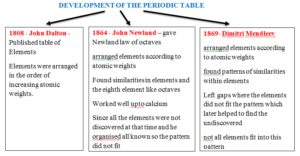
Mendleev’s Table Shortcomings
- Argon atoms have a greater relative mass than potassium which will place Argon in the group of sodium and lithium and potassium in the group of noble gases.
- Many other elements were found not fitting this pattern and were swapped by Mendleev’s to maintain the periodicity.
Present Periodic Table
- Organise the elements in the order of increasing atomic number
- All the shortcoming due to atomic weights were solved by organising the elements in the order of increasing atomic number.
- Heavy atoms are due to the presence of different isotopes of the elements.
Banner 2
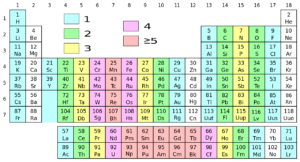
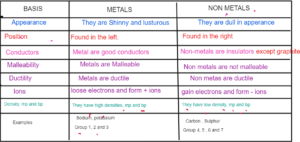
Groups in the Periodic Table
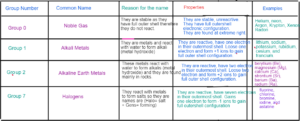
Group 1: Alkali Metals
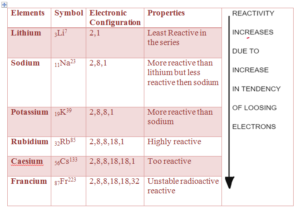
GROUP 1: Alkali Metals Physical Properties
- They are highly reactive
- Reactivity increases down the group – because tendency to loose one electron increases down the group due to increase increase in size and decrease in nuclear charge
- They loose one electron and form +1 Ions.
- They are stored in kerosene or oil to prevent them reacting from air and water
- They are soft, silvery and shinny.
- They look dull in air as they react with oxygen and form oxide which coats their surface
- Lithium is less reactive and francium is highly reactive.
- They have low melting and boiling point and the melting and boiling point decreases down the group.
Group 1: Alkali Metals Chemical Properties
REACTION WITH WATER
Reacts with water to metal hydroxide
2M + H2O 2MOH + H2
Metal hydroxide are alkali therefore the pH increases. Reactivity increases down the group so potassium reacts violently
Fizzing is produced due to the formation of hydrogen.
Eg – 2Li(s) + H2O(l) 2LiOH(aq) + H2(g)
Reaction with Oxygen
Reacts with oxygen to form a metal oxide
2M + O2 M2O
Metals go dull in air due to this reaction
4Li(s) + 4O2(g) 2Li2O(s)
Reaction with Halogens
React with halogens to form metal Halides
2M +X2 2MX [X= F, Cl, Br, I]
Metal Halides are while solids but dissolve in water to form colourless solutions.
2Li(s) + F2(g) 2LiF(s)
| LITHIUM | SODIUM | POTASSIUM |
| 2Li(s) + 2H2O (l) 2LiOH(aq) + H2(g) | 2Na(s) + 2H2O (l) 2NaOH(aq) + H2(g) | 2K(s) + H2O (l) KOH(aq) + H2(g) |
| Floats in water due to less denisty than water | Floats in water due to less density than water | Floats in water due to less density than water |
| Fizzes due to the formation of hydrogen gas. | Fizzes due to the formation of hydrogen gas. | Fizzes due to the formation of hydrogen gas. |
| Shape is retained while reacting and gets smaller. | It melts into a call while reacting. | Melts into a ball, catches fire and produces a lilac flame. |
Banner 3
WHY REACTIVITY OF GROUP 1 INCREASES DOWN THE GROUP ?
The Reactivity of Group 1 increases down the group as the tendency to loose an electron increases down the group. – React by loosing an electron
FACTORS AFFECTING TENDENCY TO LOOSE AN ELECTRON
- To loose an electron small nuclear charge greater size of atom and greater shielding is required
- Nuclear charge – Great the size of the atom, the outer electron becomes further away from the nucleus decreasing the nuclear charge
- Shielding – More the number of inner electrons due to increases in number of shell greater will be the shielding of the outer electron from the nuclear charge
- Size of the atoms – Greater the size of the atom, the outer electron will become further away from the nucleus resulting in decreases in nuclear charge
- Down the group the atom size increases due to increase in number of electron shells. This results in the outer electron being further away from the nucleus.
- As the outer electron becomes further away from the nucleus the nuclear charge decreases. Increase in number of shells also increases the shielding and shields the outer electron from the nuclear charge.
- Therefore, the tendency of atom to loose an electron increases down the grou resulting in increase in reactivity down the group.
GROUP 7 : Halogens ( Salt Forming)
| Element | Symbol | Electronic Configuration | State at Room Temperature |
| Florine | 9F19 | 2,7 | Yellow Gas |
| Chlorine | 17Cl35 | 2,8,7 | Green Gas and Pale green in solution |
| Bromine | 35Br80 | 2,8,18,7 | Volatile Brown Liquid –yellow in solution |
| Iodine | 53I127 | 2,8,18,18,7 | Volatile Purple solid – Brown in Solution |
| Astatine | 85At210 | 2,8,18,32,18,7 | Radioactive |
Banner 4
GROUP 7 : Halogens Physical Properties
- They are non metals
- They gain an electron to form -1 ions.
- They have low melting and boiling points
- Their melting point increases down the group due to increases in intermolecular forces.
- They are found in pairs and exist as diatomic molecules (X2)
- They are poisonous and smelly
- Their reactivity increase down the group
- Their density increases down the group.
- They are poor conductors of heat and electricity
HALOGEN REACTION X[F,Cl,Br,I]
REACTION WITH HYDROGEN
They react with hydrogen to form hydrogen halides.
X2(s) + H2(g) 2HX(g)
Reactivity decreases down the group so fluorine and chlorine reacts explosively and bromine and iodine reacts at higher temperature in the presence of catalyst.
REACTION WITH METALS
They react with metals to form ionic compounds. In Ionic compounds, halogens gain one electron from the metals to form -1 ions and attain noble gas electronic configurations.
2Na(s) + Cl2(g) NaCl(s)
Mg(s) + Cl2(g) MgCl2(s)
DISPLACEMENT REACTION
The more reactive halogen displaces the less reactive halogen from its salt
As the reactivity decreases down the group, the halogen at the top can take the position of the halogen at the bottom in its compounds and will displace the less reactive halogen.
Cl2 + 2NaBr 2NaCl + Br2(yellow solution formed)
(more (salt of less reactive (chlorine being more reactive has taken the reactive) halogen than Chlorine) position of less reactive bromine in its
compounds)
Cl2 +2NaF No reaction
F2 – can displace all halogens
Cl2 – can displace all Halogen except Fluorine
Br2 – can displace only Iodine
F Cl Br I
decreasing reactivity
WHY REACTIVITY OF GROUP 7 DECREASES DOWN THE GROUP ?
The Reactivity of Group 7 decreases down the group as the electron affinity or tendency to gain the electron decreases down the qroup. – React by gaining electron
Banner 5
FACTORS AFFECTING TENDENCY TO GAIN AN ELECTRON
- To gain an electron, smaller nuclear charge smaller size and less shielding is required
- Nuclear Charge – Smaller the size of the atom, greater will be the force of the nucleus as the electron will be closer to the nucleus.
- Shielding – Less electrons and shells, smaller will *be the shielding which will in turn increa the nuclear charge.
- Size of Atom – Greater the size of the atom, the outer electron will become further away from th nucleus resulting in decreases in nuclear charge
- Down the group the atom size increases due to increase in number of electron shells. As a result the nuclear charge decreases.
- The size of the atom also increases down the group which makes the nuclear charge weaker
- The electron shells also increases which decreases the effective nuclear charge on the incoming electron.
- Due to all these factors, the nuclear charge decreases which decreases the tendency of gaining electrons down the group of halogen making them less reactive.
COMPARISON BETWEEN GROUP 1 and GROUP 7
| GROUP 1 Alkali Metals | GROUP 7 Halogens |
| a) Have one electron in their outermost shells | Have seven electrons in their outermost shell |
| b) They are metals | They are non metals |
| c) They react by loosing electrons | They react by gaining electrons |
| d) They form +1 ions | They form -1 ions |
| e) Their reactivitiy increases down the group | Their reactivity decreases down the group |
| f) Reactivity depends on tendency to loose an electron | Reactivity depends on tendency to gain an electron |
Baneer 6
TRANSITION METALS
- Found between group 2 and group 3
- They are hard
- They are strong
- They are malleable and ductile
- They have higher densities than group 1 and group 2 hence they are used in construction purpose like iron.
- They show variable oxidation states
- They are used commercially as catalyst
- They form coloured compounds.
- They show the reaction with oxygen, water and halogen like group 1 but they react much slowly than alkali metals.
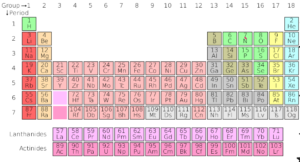
Banner 7
Periodic Table – A table that shows arrangement of all the known elements in the order of increasing atomic number. The table is organised into periods and groups.
Metals- Elements found to the left of the periodic table which are soft, shinny, conductors malleable and ductile eg Group 1; group 2 and group 3 elements
Non Metals — Elements found to the right of the periodic table which are dull, insulators Group 4,516 and 7 are non metals.
Halogens Group 7 elements are halogens as they are salt forming.
Alkali Metals Group 1 elements which react with water to form alkali
Noble Gases — Group 0 elements which are stable and do not react as they have complete outer shell
Elements found between group 2 and group 3 which have high densities, show variable oxidation states
Transition Metals and form coloured compounds
Periods- Horizontal rows of the periodic table
Groups – Vertical columns of the periodic table
Group Number – Indicates the number of electrons in the outermost shell.
Alkali Bases that are soluble in water
Displacement Reaction — When a more reactive element displaces the less reactive element from its salt
Banner 8
Q1 Look at the periodic table and give two examples of each
Metal — Li, Na
Non Metal – O2, F2
Alkali Metal – K, Li
Halogens – F, Cl
Noble Gas – He, Ar
Semi metal or metalloid – Si
Metals that form +1 ions – Li, K
Non metal that form -1 ions – F, Cl
Metal that form +2 ions – Mg, Ca
Transition metal – Fe, Cu
Q2 Write the name of most reactive halogen and most reactive alkali metals
Halogen –F Alkali Metal – Fr
Q3 Why the alkali metals gets more reactive down the group
Down the group the atom size increases due to increase in number of electron shells. This results in the outer electron being further away from the nucleus. As the outer electron becomes further away from the nucleus the nuclear charge decreases. Increase in number of shells also increases the shielding and shields the outer electron from the nuclear charge. Therefore, the tendency of atom to loose an electron increases down the group resulting in increase in reactivity down the group.
Q4 Why halogens get less reactive down the group
Down the group the atom size increases due to increase in number of electron shells. As a result the nuclear charge decreases. The size of the atom also increases down the group which makes the nuclear charge weaker. The electron shells also increases which decreases the effective nuclear charge on the incoming electron. Due to all these factors, the nuclear charge decreases which decreeases the tendency of gaining electrons down the group of halogen making them less reactive.
Q5 Write the balanced chemical equation with state symbols of
- a) Potassium with water
2K(s) + 2H2O(g) 2KOH(aq) +H2(g)
- b) Lithium with oxygen
4Li(s) + O2(g) 2Li2O (s)
- c) Sodium with bromine
2Na(s) + Br2(l) 2NaBr (s)
- d) Chlorine with hydrogen
Cl2 (s) + H2(g) 2HCl (g)
Q6 Explain displacement reaction of halogens with examples.
F2 + 2NaCl 2NaF + Cl2
Cl2 +2NaF No reaction
Banner 9
Disclaimer:
I have tried my level best to cover the maximum of your specification. But this is not the alternative to the textbook. You should cover the specification or the textbook thoroughly. This is the quick revision to help you cover the gist of everything. In case you spot any errors then do let us know and we will rectify it.
References:
BBC Bitesize
Wikipedia
Wikimedia Commons
Image Source:
Wikipedia
Wikimedia
Commons
Flickr
Pixabay
Make sure you have watched the above videos and are familiar with the key definations before trying these questions. It is also good to time yourself while doing these questions so that you can work on the speed as well.
C2-Chemistry Of The Periodic Table
- Periodic Table 1 MS
- Periodic Table 1 QP
- Periodic Table 2 MS
- Periodic Table 2 QP
- Periodic Table 3 MS
- Periodic Table 3 QP
- Properties of Transition Metals 1 MS
- Properties of Transition Metals 1 QP
- Properties of Transition Metals 2 MS
- Properties of Transition Metals 2 QP
- Properties of Transition Metals 3 MS
- Properties of Transition Metals 3 QP
